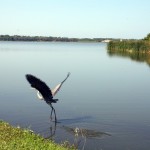She weaves in and out of traffic as she drives through the heart of downtown St. Petersburg. Her pulse races after an old lady cut her off and then slammed on the breaks. She hasn’t even made it to work yet and already she can’t wait to go home and nurse a longneck.

Anhinga, Lake Maggiore (Patricia Seffrin)
As the building starts to fade in the distance she hears birds chirping in the trees, lizards running through the dry grass, and the sound of her footsteps as she walks along the shelled path. The breeze dances around her face while the tree limbs sway. She reaches her favorite spot and sits on a fallen tree snag that overlooks Lake Maggiore. Common moorhens utter their high pitch cry as they acknowledge her presence and a gopher tortoise walks nonchalantly by in search of some wiregrass. Ospreys circle overhead in hunting for an aquatic morsel. She is sitting in a lush nature preserve and yet the tall buildings of downtown St. Petersburg looms in the distance. Boyd Hill Nature Preserve makes her feel like she is in the wilderness and yet it sits in the heart of Pinellas County, the most densely populated county in Florida. Boyd Hill serves as an oasis for wildlife that thrives in the city.
Many animals have no problem adapting their lifestyle in the human urban environment. Somehow, people always have a hard time accepting them. No matter how hard people try to remove them from their buildings and yards, they always have a way of returning. Take bats for example. Many of the common species that thrive in the St. Petersburg area actually prefer man-made dwellings rather than homes created by Mother Nature. Many people don’t even realize that they have a colony of insect eating bats living in their barrel tile roofs or their attics.
Go to any outdoor restaurant in St. Petersburg and one will almost be guaranteed to compete with a flock of boat-tailed grackles over food. These birds have no problem sitting on the chair next to a human and squawk to their hearts content until the human foolishly decides to share a French fry, thus causing a chaotic swarm of fighting birds and the chance of bird doodle dropping onto the dinner plate. One may notice that there is no population problem amongst these avian critters.
Pinellas County is almost completely built out. Only 10% of the land is set aside for conservation. Yet, the nature tourism market is thriving. People flock from all over the United States (and other countries) to get a taste of white sandy beaches and to walk amongst Florida’s unique wildlife; including the oasis of Boyd Hill Nature Preserve. To these people, wilderness still exists. They still pay to enjoy a natural paradise and yet they still get to enjoy the luxuries of the city; hot showers, delicious dining, and souvenir shops.

Great blue heron (Robin Shwedo)
When a person visits Boyd Hill Nature Preserve, he or she is coming to experience the wilderness of St. Petersburg. One would never think that a city as urbanized as St. Petersburg would have 245 acres of lush flora and fauna. And yet it sits on the Great Florida Birding Trail and is a Mecca to bird enthusiasts and other nature lovers alike. Come in the spring and take a pick of herons, egrets, spoonbills, osprey, bald eagles, owls, alligators, coyotes, snakes, etc. People can enjoy the shade of a dewy oak hammock or experience the dryness of the endemic Florida sand scrub. When they leave they are engulfed once again by buildings and traffic. Hopefully they have left their problems behind so that they may have room for new ones.
